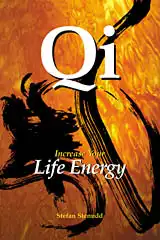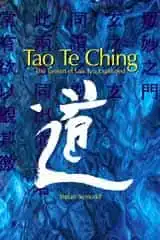|
Tao Te Ching
THE TAOISM OF LAO TZU
|
Tao Te Ching
|
The Book
The Taoism of Lao Tzu Explained. The great Taoist philosophy classic by Lao Tzu translated, and each of the 81 chapters extensively commented. Click the image to see the book at Amazon (paid link). |
Moderation
This chapter obviously continues the reasoning of the previous one. The 11th chapter's theme of emptiness is followed by this chapter's praise of moderation.
The five colors in the Chinese tradition are green, red, yellow, white, and black. The five tones of the Chinese musical scale are C, D, E, G, and A. The five flavors are sweet, bitter, salty, sour, and pungent.
This division into five is likely to have come from the Chinese concept of the five elements: water, fire, wood, metal, and earth. In ancient China it was believed that everything in the world was made up of these five materials. This can be compared to the old Greek elements, which were four: fire, earth, air, and water.
Lao Tzu warns against any form of excess. A multitude of colors is chaotic, straining for the eyes to watch, and not a pretty sight. Any artist would agree. Similarly, all the instruments in the orchestra playing at once should not go on for long. It works in a crescendo, but rarely elsewhere. A skilled chef limits the number of flavors on a dish, or none of them becomes delightful. Disciplined moderation is a key to great art of whatever genre. Less is more.
This is not only true for art, but for life in general. If we stimulate ourselves with noise, excitement, and hurried action, then our minds start to boil and reason escapes them. There are moments when intensity is unavoidable, maybe also cherished, but they should be few, and there should be generous pauses between them.
Not only does excess of this kind confuse the mind, but it dulls it, too. Adventures lose their appeal when they become routine. Nothing is so exhilarating that we can do it constantly without getting bored. Any thrill needs to be exotic. The more familiar it gets, the less of a thrill it becomes. That's the practical reason for avoiding gluttony of any kind.
Precious objects, no matter how tempting, should not lead our steps. They are just things. If we allow them to control our lives, we are sure to choose paths that have the least to do with what we need. Of true and lasting value is what happens inside of us, so a step towards anything else can only take us farther away from it. A true quest both begins and ends within ourselves. Every other direction is a roundabout.
The Belly
The sage stays within, caring for the needs of his belly instead of striving for what his eyes can see. This refers not only to making sure of getting food, before searching for other delights. In the Eastern tradition, the stomach is regarded as far more than the location of one's intestines. It's the seat of personal resources, even awareness of sorts. The stomach is the center of the human body.Traditionally, the belly is also the center of personal power. Of course, this is quite accurate from a medical standpoint, since the stomach processes the food and extracts the nutrition and energy we need to survive. The old Chinese teaching also tells us that inside the belly is the major source of the vital breath, the life force ch'i (also spelled qi). See more about the vital breath in my comments on chapter 10.
According to this tradition, the center of the stomach is tan t'ien (also spelled dantian), the red rice field, from which great energy emerges. To stimulate the flow of life force within yourself, you need to focus on this center and act according to its impulses.
So, when Lao Tzu says that we should attend to our belly, instead of what our eyes can see, he also means that we should make sure to stay centered. Focusing on the belly keeps you grounded and collected. It's how to guard your integrity and get to know yourself properly. When our eyes trick us to forget what our bellies tell us, our minds get lost and our bodies are sure to suffer.
Lao Tzu reminds us to get our priorities right. In doing so, we get to know ourselves and stay true to what we really are. What the eyes show us may very well be illusions, but what we feel inside our bellies is for real.
NEXT
Tao Te Ching Explained
Preface
Introduction
Literature
translated and explained by Stefan Stenudd.
1 |
2 |
3 |
4 |
5 |
6 |
7 |
8 |
9 |
10 |
11 |
12 |
13 |
14 |
15 |
16 |
17 |
18 |
19 |
20 |
21 |
22 |
23 |
24 |
25 |
26 |
27 |
28 |
29 |
30 |
31 |
32 |
33 |
34 |
35 |
36 |
37 |
38 |
39 |
40 |
41 |
42 |
43 |
44 |
45 |
46 |
47 |
48 |
49 |
50 |
51 |
52 |
53 |
54 |
55 |
56 |
57 |
58 |
59 |
60 |
61 |
62 |
63 |
64 |
65 |
66 |
67 |
68 |
69 |
70 |
71 |
72 |
73 |
74 |
75 |
76 |
77 |
78 |
79 |
80 |
81 |
Tao Te Ching Explained
James Legge's Tao Te Ching
Aleister Crowley's Tao Te Ching
The 1st Chapter of Tao Te Ching in 76 Versions
Lao Tzu — Legendary Author of Tao Te Ching
My Taoism BooksClick the image to see the book at Amazon (paid link).
The Taoism of Lao Tzu Explained. The great Taoist philosophy classic by Lao Tzu translated, and each of the 81 chapters extensively commented. |
About Cookies
My Other Websites:
I Ching Online
The 64 hexagrams of the Chinese classic I Ching and what they mean in divination. Try it online for free.
Qi Energy Exercises
The ancient Chinese life energy qi (chi) explained, with simple instructions on how to exercise it.
Life Energy
The many ancient and modern life force beliefs all over the world explained and compared.
Taoismen på svenska
Other Books by Stefan Stenudd
Click the image to see the book at Amazon (paid link).
 Cosmos of the Ancients
Cosmos of the Ancients
The Greek philosophers and what they thought about cosmology, myth, and the gods.
 Qi — Increase Your Life Energy
Qi — Increase Your Life Energy
The life energy qi (also chi or ki) explained, with exercises on how to awaken, increase and use it.
 Aikido Principles
Aikido Principles
Basic concepts of the peaceful martial art. Aikido principles, philosophy, and fundamental ideas.
 Life Energy Encyclopedia
Life Energy Encyclopedia
Qi, prana, spirit, ruach, pneuma, and many other life forces around the world explained and compared.
 Archetypes of Mythology
Archetypes of Mythology
Jungian theories on myth and religion examined, from Carl G. Jung to Jordan B. Peterson.
 Stefan Stenudd
Stefan Stenudd
About me
I'm a Swedish author and aikido instructor. In addition to fiction, I've written books about Taoism and other East Asian traditions. I'm also an historian of ideas, researching ancient thought and mythology. Click the image to get to my personal website.Contact

 Tao Te Ching
Tao Te Ching Tao Quotes
Tao Quotes Fake Lao Tzu Quotes
Fake Lao Tzu Quotes